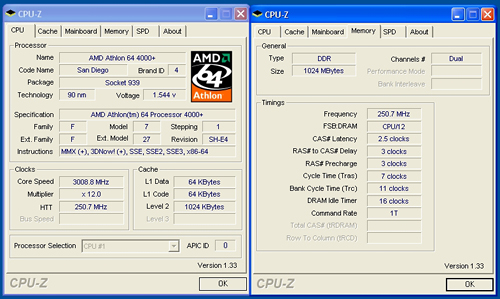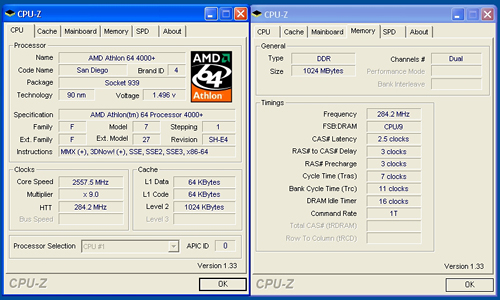FSB Overclocking Results


Our 4000+ CPU posted very good results in the stock multiplier overclocking test. We were able to reach a very stable overclock of 251HTT x12. We were also able to boot Windows with a 256HTT x12 setting but could not complete our entire test suite.
Unfortunately, our maximum HTT speed attained was 284HTT x9. The board could POST at 292HTT x9 but was not stable. We were unable to POST at 300HTT or higher, though this processor has completed testing at a 330HTT x9 setting in the past.
We have contacted MSI engineering at this time and hopefully our results are due to a below average board as end users and other websites have exceeded the 300HTT level with the 3.0a BIOS. 284HTT isn't terrible, particularly when using higher CPU multipliers, but neither is it exceptional. Also, voltage levels remained consistent throughout testing. We did not notice any abnormal or out of range voltage fluctuations with this board.


Our Opteron 170 posted excellent results at the stock CPU multiplier settings but was hampered once again at the lower multiplier setting. At these overclocked settings the system was able to complete all of our benchmark test suites three consecutive times and run Prime95 for a minimum of four hours without issue. Overall the board would make an excellent platform for overclocking if the maximum HTT settings are improved.
Memory Stress Testing
Memory stress tests look at the ability of the MSI K8N Diamond Plus to operate at the officially supported memory frequencies of DDR-400 at the best performing memory timings the OCZ PC4800 Platinum Edition will support.
The MSI K8N Diamond Plus was superbly stable with 2 DDR modules in Dual-Channel mode at the settings of 2-2-2-5 at 2.7v. We were able to operate the memory at this configuration up to a 227HTT x12 setting. We will now install all four available memory slots that results in more strenuous requirement on the memory subsystem than testing 2 DDR modules on a motherboard.
The MSI K8N Diamond Plus was extremely stable with 4 DDR modules in Dual-Channel operation at the settings of 2-2-2-8 but required the command rate be increased to 2T along with a voltage increase to 2.75. We tested memory modules from several different suppliers with the same results.
| Front Side Bus Overclocking Testbed | |
| Processor | AMD Athlon 64 4000+ (San Diego) AMD Opteron 170 (Denmark) |
| CPU Voltage AMD Athlon 64 4000+ AMD Opteron 170 |
1.550V (1.400V default) 1.550V (1.350V default) |
| Memory Settings | 2.5-3-3-7 1T - (12x) 2.5-3-3-7 1T - (10x) 2.5-3-3-7 1T - (9x) |
| Memory Voltage | 2.8V |
| HT Multiplier | 4x - 250HTT ~ 285HTT |
| Memory | OCZ PC4800 Platinum Edition |
| Cooling | Tuniq Tower 120 |
| Power Supply | PC Power and Cooling 850 SSI |
| Maximum CPU Overclock AMD Athlon 64 4000+ |
251HTT x 12 (3008MHz) +25% |
| Maximum HTT Overclock AMD Athlon 64 4000+ |
284HTT x 9 (2557MHz) +42% |
| Maximum CPU Overclock AMD Opteron 170 |
284HTT x 10 (2841MHz) +42% |
| Maximum HTT Overclock AMD Opteron 170 |
282HTT x 9 (2543MHz) +41% |


Our 4000+ CPU posted very good results in the stock multiplier overclocking test. We were able to reach a very stable overclock of 251HTT x12. We were also able to boot Windows with a 256HTT x12 setting but could not complete our entire test suite.
Unfortunately, our maximum HTT speed attained was 284HTT x9. The board could POST at 292HTT x9 but was not stable. We were unable to POST at 300HTT or higher, though this processor has completed testing at a 330HTT x9 setting in the past.
We have contacted MSI engineering at this time and hopefully our results are due to a below average board as end users and other websites have exceeded the 300HTT level with the 3.0a BIOS. 284HTT isn't terrible, particularly when using higher CPU multipliers, but neither is it exceptional. Also, voltage levels remained consistent throughout testing. We did not notice any abnormal or out of range voltage fluctuations with this board.


Our Opteron 170 posted excellent results at the stock CPU multiplier settings but was hampered once again at the lower multiplier setting. At these overclocked settings the system was able to complete all of our benchmark test suites three consecutive times and run Prime95 for a minimum of four hours without issue. Overall the board would make an excellent platform for overclocking if the maximum HTT settings are improved.
Memory Stress Testing
Memory stress tests look at the ability of the MSI K8N Diamond Plus to operate at the officially supported memory frequencies of DDR-400 at the best performing memory timings the OCZ PC4800 Platinum Edition will support.
| MSI K8N Diamond Plus Stable DDR-400 Timings - 2 DIMMs (2/4 slots populated - 1 Dual-Channel Bank) |
|
| Clock Speed | 200MHz |
| CAS Latency | 2 |
| RAS to CAS Delay | 2 |
| RAS Precharge | 2 |
| RAS Cycle Time | 5 |
| Command Rate | 1T |
| Voltage | 2.7V |
The MSI K8N Diamond Plus was superbly stable with 2 DDR modules in Dual-Channel mode at the settings of 2-2-2-5 at 2.7v. We were able to operate the memory at this configuration up to a 227HTT x12 setting. We will now install all four available memory slots that results in more strenuous requirement on the memory subsystem than testing 2 DDR modules on a motherboard.
| K8N Diamond Plus Stable DDR-400 Timings - 4 DIMMs (4/4 slots populated - 2 Dual-Channel Banks) |
|
| Clock Speed | 200MHz |
| CAS Latency | 2 |
| RAS to CAS Delay | 2 |
| RAS Precharge | 2 |
| RAS Cycle Time | 8 |
| Command Rate | 2T |
| Voltage | 2.75V |
The MSI K8N Diamond Plus was extremely stable with 4 DDR modules in Dual-Channel operation at the settings of 2-2-2-8 but required the command rate be increased to 2T along with a voltage increase to 2.75. We tested memory modules from several different suppliers with the same results.










42 Comments
View All Comments
OvErHeAtInG - Tuesday, April 18, 2006 - link
Let me be the devil's advocate here. I know AT reviews (and others) usually regard same-colored RAM slots to be "correct" for dual-channel operation, but for me it's always made more sense when it's like this MSI board--one color for each channel. Of course, it wouldn't be confusing if manufacturers just chose one standard color scheme and left it at that.Gary Key - Thursday, April 20, 2006 - link
We completely agree about having a standard color scheme. The majority of boards have different colors for dual channel operation so our comments are based this fact. A previous MSI board we tested followed this pattern and then they change it on this board. It is too confusing in my opinion when a single supplier cannot agree on a color scheme between board releases. This is certainly not an MSI only issue either. :)
Wesleyrpg - Tuesday, April 18, 2006 - link
Hmmm, is this common knowledge? One of my friends suffers from this so badly that we had to set up his cable modem for use the the USB port (yuck). Is there a workaround/beta drivers? I'm sure NVIDIA wouldnt want this leaked if it was true? Why havent they done anything about it? The current AMD driver 6.70 is about 6 months old now and still corrupts data. Damn them!!!!
Gary Key - Thursday, April 20, 2006 - link
Yes, this is fairly common knowledge and we have actually referred readers to NVIDIA for assistance. I do have a new set of drivers for the Business Platform system and will be testing them next week.
Wesleyrpg - Tuesday, April 18, 2006 - link
hmmm, seems NVIDIA have more than just an issue with their ActiveArmor, from what i have been reading theres also huge problems with the IDE/SATA file tranfers as well. Wish i'd know about these issues earlier, up until today i been recommending the NFORCE4, but with all these issues its hard to recommend them at all. Why hasnt any articles been written up on the MAJOR issues with the Nforce4 chipset?Per Hansson - Sunday, April 16, 2006 - link
Just replying to your message to me in the other mobo review "Please email me - I have the photographs. We are doing some revisions on the engine and could not get these in but I did take the photographs for you."I'm not the one that needs the pictures, I can identify the caps anyway... I was just thinking that it would be a nice addition to your articles, incase there where other readers that where interested in this too...
This board looks really nice though, United Chemicon KZG everywhere it seems, except for the Sanyo Polymers at the VRM and plenty more than what should "really" be necessary for a budget board like this... (okay, there looks to be one or four odd caps in the PCI section but they do oftenly not see very much ripple current so it should be ok)
tekkstore - Monday, April 17, 2006 - link
http://www.tekkstore.com">tekkstore.comAnnonymousCoward - Friday, April 14, 2006 - link
Macs still don't have a right mouse button? When will they put their stubbornness behind?goinginstyle - Wednesday, April 12, 2006 - link
I think you guys need to check your facts on the southbridge. According to the HardOCP article the board has the ULi 1575 southbridge. Are you sure the board has the nforce4 sli on the southbridge as that chipset is usually on the northbridge .Gary Key - Wednesday, April 12, 2006 - link
We will not comment in an open forum about another website's information that might or might not have been posted. However, I can ensure you this board utilizes the NVIDIA nForce4 SLI for the Southbridge (MCP) and the C51D for the Northbridge (SPP) as explained on the front page. If you still question our statements, then please visit MSI's website where the chipset information is available for this board - http://www.msi.com.tw/program/products/mainboard/m...">MSI K8N DiamondThanks!